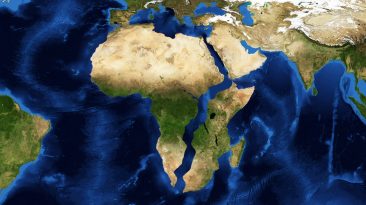Mountains. They’re born, they grow, they age and erode. And after a very, very long life, they turn to dust. What if all mountains collapsed at once?
What are the forces that might cause this to happen? Could humans withstand the effects?
We see mountains deteriorate all the time. A 2015 earthquake that struck the Himalayas triggered thousands of landslides at once, wreaking havoc on the villages below.
Melting ice can also cause mountainsides to crumble if the ice is integral to the mountain’s structural stability. With climate change, this kind of collapse becomes all the more likely.
Volcanoes are another big threat. The 2018 Anak Krakatau disaster in Indonesia saw the volcanic peak lose more than two-thirds of its height and volume in a single week.
But how much worse does it get when more than one mountain crumbles? What would it take for all the world’s mountains to collapse? And what happens to you?
For years, scientists struggled to explain why North America’s version of the Andes Mountains had disappeared. Situated mostly over the Basin and Range province between the US and Mexico, this bygone mountain range left evidence of its former glory behind, without explaining why it went away.
[dx_custom_adunit desktop_id=”RTK_CDE4″ mobile_id=”RTK_SUFd”]A team of geophysicists at Melbourne’s Monash University came up with a theory for why it collapsed. They studied the movement of tectonic plates; more specifically, subduction zones. A subduction zone is created when two plates converge, forcing one to slide underneath the other.
Subduction zones can form mountains, but they can also bring them down. When subduction zones decrease in size, the velocity of the two plates is affected as well, and that change creates a pull that drives mountains to collapse.
Of course, this doesn’t happen overnight. The fall of the Basin and Range mountains played out over tens of millions of years.
If humans are playing the long game on Earth, then the natural collapse of entire mountain ranges is something we might have to contend with one day.
Let’s fast-forward to a world where a combination of earthquakes, melting ice, volcanic activity, erosion, and whatever self-inflicted damage humans might cause has either wiped out or severely diminished Earth’s supply of mountains.
While it would be a tremendous achievement for civilization to last that long; withstanding the brutal landslides, eruptions, and tsunamis that occured along the way; we might not be able to bask in it for very long.
Mountains actually play a pivotal role in regulating carbon levels on Earth. The fresh rock that emerged during periods of mountain formation soaked up large amounts of carbon dioxide and helped the planet avoid sweltering, inhospitable conditions.
But mountain rocks also emit carbon through erosion and weathering. And if mountain erosion happens faster than mountain formation, then the world’s carbon dioxide levels could become exponentially worse, bringing us back to square one, where Earth is once again inhospitable to human life.
So let’s try not to peak too early! Let’s protect our mountains by doing everything we can to prevent environmental degradation!
Subscribe to What-If on Youtube or follow the show on Facebook Watch.
Sources
- “New Theory On Why Some Mountains Crumble › News In Science (ABC Science)”. 2019. abc.net.au. Accessed February 14 2019.
- “When Mountains Collapse… – Geolog”. Qiu, Jane, and Jane Qiu. 2016. Geolog. Accessed February 14 2019.
- ” When Mountains Fall Into The Sea | Hakai Magazine”. Magazine, Hakai. 2019. Hakai Magazine. Accessed February 14 2019.
- “Swiss Mountain Moved 10Cm A Year Before Crashing Down”. Matthew Allen, swissinfo.ch. 2017. SWI swissinfo.ch. Accessed February 14 2019.
- “Scientists Discover Major Source Of Carbon Release”. 2014. USC News. Accessed February 14 2019.
- “Dramatic Collapse Of Indonesian Volcano”. 2019. BBC News. Accessed February 14 2019.
- “Mountain Erosion Could Affect CO2 In The Atmosphere”. 2018. Valuewalk. Accessed February 14 2019.



























